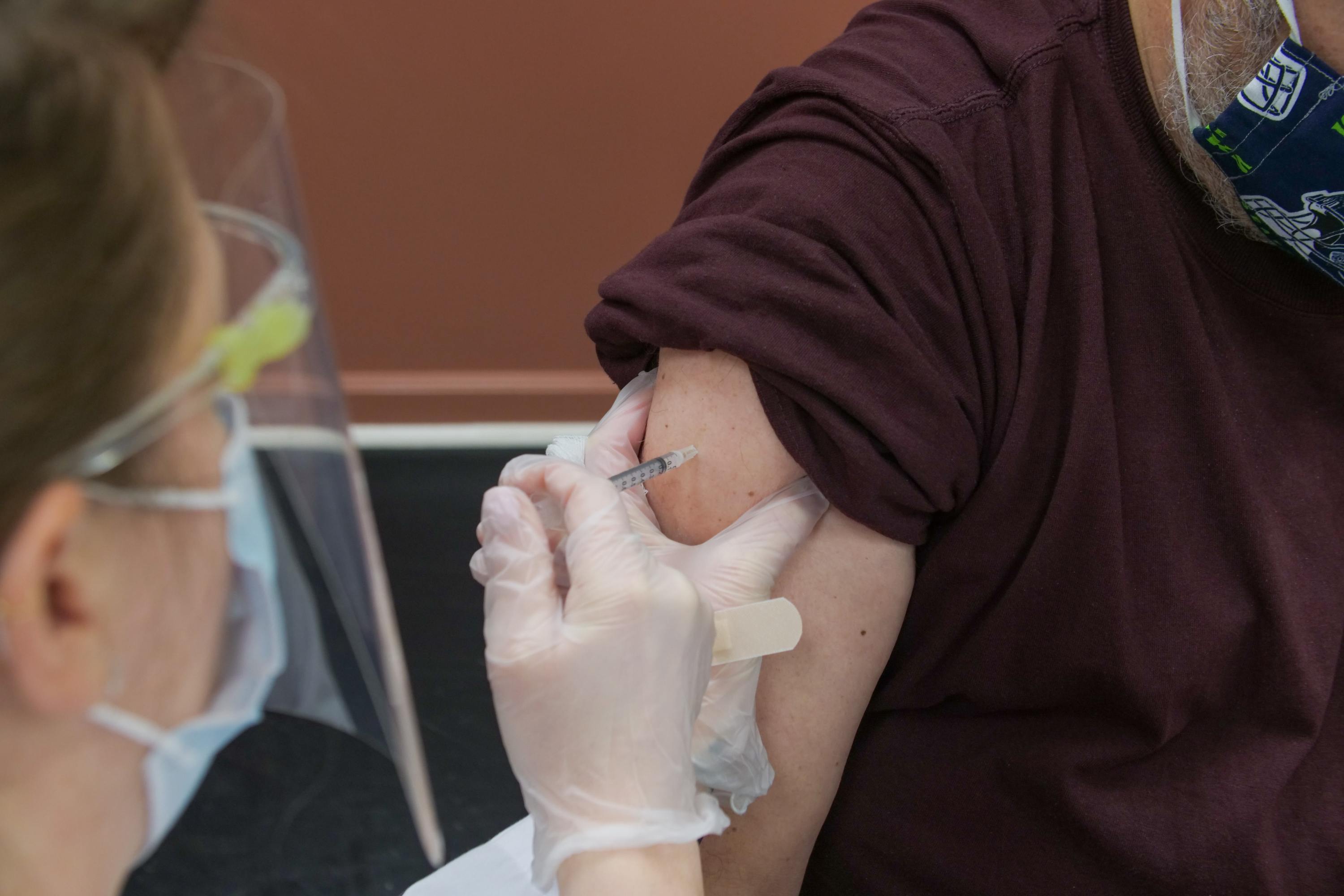This is how America gets its vaccines

After just a week in office, the Biden administration is already under immense public pressure to fix America’s mangled vaccine rollout.
Operation Warp Speed injected enormous sums into developing vaccines but left most of the planning—and cost—of administering them to states, which are now having to cope with the fallout. The reliance on chronically underfunded health departments has exposed a threadbare digital ecosystem in which manual data entry, unscalable though it is, is often the fastest way to fix things that break.
Compounding the problem, local leaders have repeatedly complained about inconsistent vaccine supplies. The lack of top-down coordination and communication has led to thousands of appointment cancellations and countless doses tossed in the trash.
Biden’s newly released pandemic strategy is organized around a central goal: to oversee administration of 100 million vaccines in 100 days. To do it, he'll have to fix the mess.
Some critics have called his plan too ambitious; others have said it’s not ambitious enough. It’s guaranteed to be an uphill battle. But before we get to the solutions, we need to understand how the system operates at the moment—and which aspects of it should be ditched, replaced, or retained.
From manufacturer to patient
At the federal level, two core systems sit between the vaccine factories and the clinics that will administer the shots: Tiberius, the Department of Health and Human Services’ vaccine allocation planning system, and VTrckS, the Centers for Disease Control and Prevention’s vaccine ordering portal.
Tiberius takes data from dozens of mismatched sources and turns it into usable information to help state and federal agencies plan distribution. VTrckS is where states actually order and distribute shots.
The two are eons apart technologically. Whereas Palantir built Tiberius last summer using the latest available technology, VTrckS is a legacy system that has passed through multiple vendors over its 10-year existence. The two are largely tied together by people downloading files from one and uploading them to the other.
Dozens of other private, local, state, and federal systems are involved in allocating, distributing, tracking, and administering vaccines. Here’s a step-by-step explanation of the process.
Step one: Manufacturers produce the vaccine
HHS receives regular production updates from Pfizer and Moderna. The manufacturers communicate estimated volumes in advance to help HHS plan before confirming real production numbers, which are piped into Tiberius.
Both vaccines are made using messenger RNA, a biotechnology that’s never been produced at scale before, and they need to be kept extremely cold until just before they go into a needle: Moderna’s must be kept at -25 to -15 °C, while Pfizer’s requires even lower temperatures of -80 to -60 °C. In the fall, it became clear that manufacturers had overestimated how quickly they could distribute doses, according to Deacon Maddox, Operation Warp Speed’s chief of plans, operations, and analytics and a former MIT fellow.
“Manufacturing, especially of a nascent biological product, is very difficult to predict,” he says. “You can try, and of course everybody wants to you try, because everybody wants to know exactly how much they’re going to get. But it’s impossible.”

This led to some of the first stumbles in the rollout. While training the states on how to use Tiberius, Operation Warp Speed entered those inflated estimates into a “sandbox” version of the software so states could model different distribution strategies for planning purposes. When those numbers didn’t pan out in reality, there was confusion and anger.
“At the end of December, people were saying, ‘We were told we were going to get this and they cut it back.’ That was all because we put notional numbers into the exercise side, and folks assumed that was what they were going to get,” says Maddox. “Allocation numbers are highly charged. People get very emotional.”
Step two: The federal government sets vaccine allocations
Every week, HHS officials look at production estimates and inventory numbers and decide on the “big number”—how many doses of each vaccine will go out to states and territories in total. Lately, they’ve been sticking to roughly 4.3 million per week, which they’ve found “allows us to get through lows in manufacturing, and save through highs,” Maddox says.
That number goes into Tiberius, which divvies up vaccines on the basis of Census data. Both HHS and media reports have sometimes described this step as using an algorithm in Tiberius. This should not be confused with any kind of machine learning. It’s just simple math based on the allocation policy, Maddox says.
Thus far, the policy has been to distribute vaccines according to each jurisdiction’s adult (18+) population. Maddox says the logic in Tiberius could easily be updated should Biden decide to do it on another basis, such as elderly (65+) population.
Once Operation Warp Speed analysts confirm the official allocation numbers, Tiberius pushes the figures to jurisdictions within their version of the software. An HHS employee then downloads the same numbers in a file and sends them to the CDC, where a technician manually uploads it to set order limits in VTrckS. (You can think of VTrckS as something like an online store: when health departments go to order vaccines, they can only add so many to their cart.)
Even that hasn’t been an exact science. Shortly before the inauguration, in a phone call with Connecticut governor Ned Lamont, outgoing HHS secretary Alex Azar promised to send the state 50,000 extra doses as a reward for administering vaccines efficiently. The doses arrived the next week.
The deal was representative of “the rather loose nature of the vaccine distribution process from the federal level,” Lamont’s press secretary, Max Reiss, told us in an email.
Step three: States and territories distribute the vaccine locally
State and territory officials learn how many vaccines they’ve been allotted through their own version of Tiberius, where they can model different distribution strategies.
Tiberius lets officials put data overlays on a map of their jurisdiction to help them plan, including Census data on where elderly people and health-care workers are clustered; the CDC’s so-called social vulnerability index of different zip codes, which estimates disaster preparedness on the basis of factors like poverty and transportation access; and data on hospitalizations and other case metrics from Palantir’s covid surveillance system, HHS Protect. They can also enter and view their own data to see where vaccination clinics and ultra-cold freezers are located, how many doses different sites have requested, and where vaccines have already gone.
Once states decide how many doses of each vaccine they want to send to each site, they download a file with addresses and dose numbers. They upload it into VTrckS, which transmits it to the CDC, which sends it to manufacturers.

Last week, Palantir rolled out a new “marketplace exchange” feature, effectively giving states the option to barter vaccines. Since the feds divvy up both Moderna and Pfizer vaccines without regard to how many ultra-cold freezers states have, rural states may need to trade their Pfizer allotment for another state’s Moderna shots, Maddox says.
When thinking about the utility of the system, it’s worth noting that many health departments have a shallow bench of tech-savvy employees who can easily navigate data-heavy systems.
“It’s a rare person who knows technology and the health side,” says Craig Newman, who researches health system interoperability at the Altarum Institute. “Now you throw in large-scale epidemiology…it’s really hard to see the entire thing from A to Z.”
Step four: Manufacturers ship the vaccines
Somehow, shipping millions of vaccines to 64 different jurisdictions at -70 °C is the easy part.
The CDC sends states’ orders to Pfizer and to Moderna’s distribution partner McKesson. Pfizer ships orders directly to sites by FedEx and UPS; Moderna’s vaccines go first to McKesson hubs, which then hand them off to FedEx and UPS for shipping.
Tracking information is sent to Tiberius for every shipment so HHS can keep tabs on how deliveries are going.
Step five: Local pharmacies and clinics administer the vaccine
At this point, things really start to break down.
With little federal guidance or money, jurisdictions are struggling with even the most basic requirements of mass immunization, including scheduling and keeping track of who’s been vaccinated.
Getting people into the clinic may intuitively seem easy, but it’s been a nightmare almost everywhere. Many hospital-based clinics are using their own systems; county and state clinics are using any number of public and private options, including Salesforce and Eventbrite. Online systems have become a huge stumbling block, especially for elderly people. Whenever jurisdictions set up hot lines for the technologically unsavvy, their call centers are immediately overwhelmed.
Even within states, different vaccination sites are all piecing together their own hodgepodge solutions. To record who’s getting vaccines, many states have retrofitted existing systems for tracking children’s immunizations. Agencies managing those systems were already stretched thin trying to piece together messy data sources.

It may not even be clear who’s in charge of allocating doses. Maddox described incidents when state officials contacted HHS to say their caps were too low in VTrckS, only to realize that someone else within their office had transferred doses to a federal program that distributes vaccines to long-term care homes, without telling other decision makers.
“Operation Warp Speed was an incredible effort to bring the vaccine to market quickly," and get it to all 50 states, says Hana Schank, the director of strategy for public interest technology at the think tank New America. “All of that was done beautifully." But, she says, the program paid little attention to how the vaccines would actually get to people.
Many doctors, frustrated by the rollout, agree with that sentiment.
“How much money was put into the science of making the vaccine? How much money is being put into the distribution?” says Courtney Rowe, a pediatric urologist in Connecticut who’s been volunteering at her hospital’s vaccination clinic. “It doesn’t matter that you made it if you can’t distribute it.”
Theoretically, when patients do manage to get a shot, clinicians are supposed to log information about the appointment and send it to their jurisdiction’s immunization registry. Those registries are aggregated in a different federal system called the CDC Clearinghouse, which is supposed to de-identify the records and forward the data to yet another federal system, called the IZ Data Lake, according to Maddox. This software then feeds it back into Tiberius.
States and feds both use those numbers to track what proportion of vaccines received are actually being administered.
There are a couple of reasons not to trust that data. One is that states, and even individual vaccination sites, have widely varying rules around reporting vaccination data to the jurisdiction’s registry. Clinic workers in multiple states have found the new requirements so onerous they’ve started writing all the vaccination records on paper and entering them into the computer by hand when they have free time.
“There’s just a lot of manual stuff, so then you get a delay in the data,” said Brendan Babb, the chief innovation officer of Anchorage, Alaska, during a January 25 press call with New America. “As much as that can be glued together, it’ll free time up for people and you’ll get more real-time data of where vaccines are at.”
Where do we go from here?
While much criticism has been directed to federal tech systems during the rollout, it seems they are in fact largely working. Maddox says without Tiberius, things could get far worse. “We would have to fall back on very old-fashioned ways,” he says. “We would need a lot more people, and we would need access to systems that would take us some time to recover from, and it would not be integrated.”
Experts say the bigger challenge, however, was Trump’s decision to leave vaccine administration to the states. This put significant strain on local governments, which are often understaffed, have limited technical capabilities, and must deal with outdated tech systems.
During the New America press call, several speakers emphasized that the federal government needs to take greater initiative to do things like supply states with better technology options.
Latanya Sweeney, a professor of government and technology at Harvard University, said Biden could set up a federal tech team to create better appointment scheduling software and provide it to states as an easily accessible alternative. This would not only help states save resources but offer a better user experience for those trying to book appointments, especially elderly people and non-native English speakers.
“There are rumors that the United States Digital Service might take this on … so there is hope,” says Schank. “National coordination will be a game-changer.”

Some steps are being taken in the right direction. December’s stimulus package included $9 billion to help state vaccine campaigns. HHS also recently announced $20 million will go to modernizing immunization registries, though it’s a fraction of the $500 million state public health officials estimate they will need to update aging, often non-interoperable systems. (Many systems can’t talk to each other, and often rely on employees to compensate for incompatible medical record systems. Some still accept records by fax.)
Biden’s covid plan says the administration will work with the CDC and states to “bolster” state IT systems and improve data transparency for vaccination efforts across the board, though they have yet to release a budget.
The most recent federal stimulus bill allocated over $100 billion to help jurisdictions’ vaccination campaigns, and Biden’s plan includes an additional $350 billion. And while the vaccine has always been free for jurisdictions, the rest of the bill has been on states and vaccination sites. Biden’s plan argues the federal government should pay for it all.
All of this presents an opportunity to fix a fundamental part of our safety net, one that’s been ignored for decades, according to Newman of the Altarum Institute.
“It’s really important that public health has stable resources,” he says. “They can make long term plans and not worry--nine months from now, is this going to drop off everyone’s radar? Is the funding going to evaporate?"
The bottom line, says Schank, is that Operation Warp Speed met its own goal. Now that part is over, she says, “so somebody has to pick that up.”
This story is part of the Pandemic Technology Project, supported by the Rockefeller Foundation.
Deep Dive
Policy
Is there anything more fascinating than a hidden world?
Some hidden worlds--whether in space, deep in the ocean, or in the form of waves or microbes--remain stubbornly unseen. Here's how technology is being used to reveal them.
A brief, weird history of brainwashing
L. Ron Hubbard, Operation Midnight Climax, and stochastic terrorism—the race for mind control changed America forever.
What Luddites can teach us about resisting an automated future
Opposing technology isn’t antithetical to progress.
Africa’s push to regulate AI starts now
AI is expanding across the continent and new policies are taking shape. But poor digital infrastructure and regulatory bottlenecks could slow adoption.
Stay connected
Get the latest updates from
MIT Technology Review
Discover special offers, top stories, upcoming events, and more.